There are dishes in Italian contemporary cuisine that are now part of the national culinary history. They stand out like milestones. This happens because they perfectly depict the spirit of a time, thus becoming emblematic; or because they celebrate an emblem of Italy; or because they become icons of a famous toque, a signature dish, so much so that the preparation enjoys the light shed by its author, and vice versa.
Massimo Bottura's Five ages of Parmigiano Reggiano, in different textures and temperatures have all these features in one. «When a French colleague asked me to choose ten dishes emblematic of Italian cuisine from WWII to our days, I had no doubts I had to include this», Paolo Marchi said a few weeks ago, during the press conference presenting the new partnership between Identità Golose and Parmigiano Reggiano, see A partnership of goodness: Identità and Parmigiano Reggiano together to promote Italian fine food.
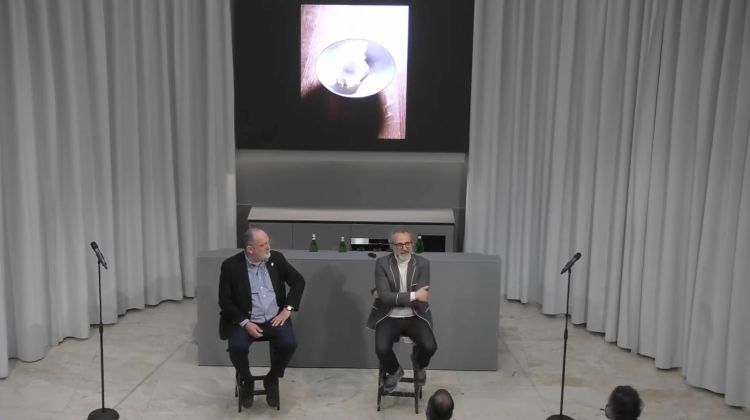
Paolo Marchi and Massimo Bottura at Identità Golose Milano during the press conference to present the new partnership between Identità Golose and Parmigiano Reggiano
Bottura was right beside Marchi. And he took this input to go through the genesis and development of an idea that became an edible icon because, as we said, it's one of the most famous recipes from the great chef from Modena; then because it's an affectionate tribute to the best cheese in the world, the outcome of that land of slow food & fast cars – as Bottura calls it – and it is also a representation of how cooking can be rooted in a people's identity; finally, because it perfectly depicts the moments that have marked the progress of its "design".
In the same way as the works for some cathedrals have lasted centuries, and thus show a stratification of styles, the overlapping of different intelligences, all focused in defining a sole body of work, coherent and harmonious; so the Five ages have a story that goes in synchrony with the spectacular story of the explosion of creative freedom in the kitchen, when the new millennium was about to begin.
The story goes back to the late 1993 («Another era, when it was unthinkable for someone to take the perfection of this cheese, a disk of sun, and change it completely», Paolo Marchi), at Trattoria del Campazzo. Seven years earlier Bottura had disappointed his father, telling him he didn't want to become a lawyer but a chef, and open his own restaurant in Campazzo, a hamlet of Nonantola (Modena). So in 1993 Bottura was not a newbie, and made use of the lessons of rezdora Lidia Cristoni, and then of Georges Cogny... But he wanted to grow, and he had a dream: «Work at Le Louis XV in Monte Carlo, with Alain Ducasse. In other words, a Frenchman who was already presenting farm-to-table, an innovative concept. And he had replaced butter with extra virgin olive oil. In France!».
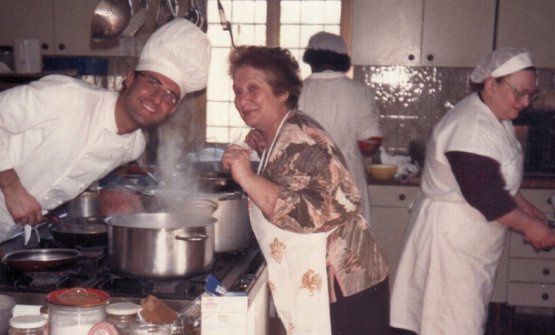
A historic photo: Massimo Bottura, his mother Luisa and, to the right, Lidia Cristoni at Trattoria del Campazzo
The opportunity to try arrived with an unexpected call from a friend, a supplier of balsamic vinegar: «Are you open tomorrow? I'm bringing Ducasse for lunch». Drumroll. Bottura explains: «The watchword at the time was terroir. Alain was convinced of this». And the chef from Modena too had been working for months on dishes that would represent his territory but also go beyond, «dishes that could acquire an important meaning, so to speak». An idea that of course had to start from two crucial ingredients, traditional balsamic vinegar from Modena and Parmigiano Reggiano: «With vinegar it was complicated, because we still didn't have enough techniques to use it in all the interpretations that could give life to a dish. Hence I prepared for Ducasse, a simple "kir alla modenese", that is to say traditional balsamic vinegar from Modena aged 30 years mixed with bubbles from Beppe Bellei». And how about Parmigiano? «I thought about textures and temperatures. Hence I started from a classic chocolate soufflé, the mi-cuit I had learnt from Cogny. And I transformed it into a mi-cuit of Parmigiano. Then I thought of a sauce of Parmigiano. Finally, a wafer of Parmigiano». Et voilà the dish. The name: Three textures and temperatures of Parmigiano Reggiano, official debut in 1994.
(Some might wonder how Ducasse's lunch went. The Frenchman was so impressed he invited Bottura to do an internship at Le Louis XV, this marking the end of Bottura's season at Campazzo, while Osteria Francescana was to open in March 1995).
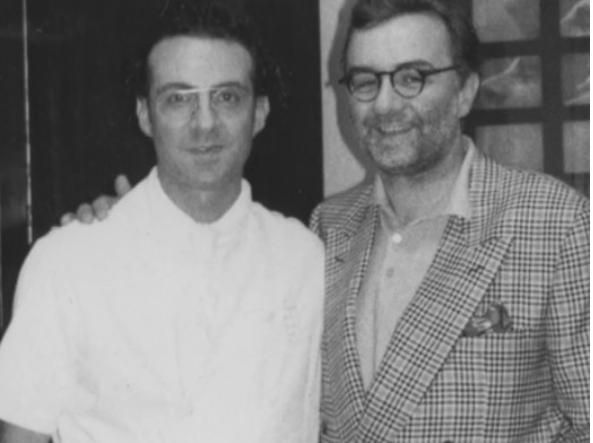
Bottura with Alain Ducasse, years ago
So the first version of the dish refers to "textures" and "temperatures". Not to ages. «At the time, they didn't exist. Or rather, very few people kept the Parmigiano cheese for longer time: it was easier to find a cheese aged 18 months. After all, you cut it, eat it and say "wow, what a fantastic umami". True. But it's also true that the ageing is crucial». The awareness of how important this was came one night, in Modena, «when farmer and gentleman
Umberto Panini paid us a visit», he wanted to taste the
Three textures and temperatures of Parmigiano Reggiano. «But I only wanted to do the best, and I offered him four. I had long been working with an iced mousse, to add a further dimension to the demi-soufflé, the sauce and the wafer. At the end of the meal
Umberto, asked me, seriously: “Have you ever thought of what ageing Parmigiano really means? It could improve your recipe". It was enlightening».
So in 1998 the dish changed its nature: «No longer one ingredient, but two: Parmigiano Reggiano and time». Because «
Umberto was right. The impalpable differences between a cheese aged 24 months and one aged 40 radically changed our recipe in terms of texture, taste and firmness»,
Bottura started to look for cheese he could age on which he added a label "
Osteria Francescana. Do not open until..."; and started to pay attention to other aspects too, the area where the cattle was bred, the diet, breed... The result was renamed into
Four ages of Parmigiano Reggiano, in different textures and temperatures (
here's the video in which a young
Bottura explains it): a cheese aged 24 months for the demi-soufflé; one aged 30 for the sauce, hot and velvety; the rind from a cheese aged 40 months to make a thin but intense wafer; and – the novelty – a syphoned mousse, «we preferred this road, to the initial one with the ice cream, because it wasn't very successful, unless you ate it right away it started to melt». Of course, in the choice of the mousse one could notice an echo of
elBulli: «We had heard of the work of
Ferran Adrià. In Modena we made the mousse after enlarging the hole of a bar syphon, with a small drill». Soon
Bottura would go to acquire some experience in Cala Montjoi too.
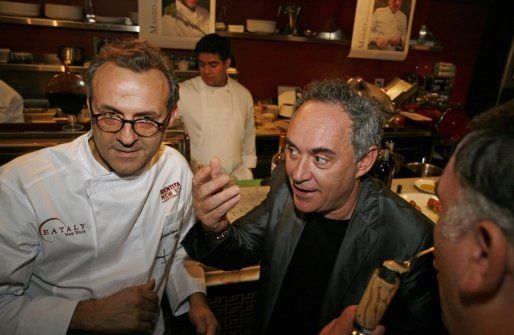
Massimo Bottura with Ferran Adrià at Identità New York 2010
And it was right there, at the court of king Ferran, in the summer of 2000, that the chef from Modena got the inspiration for the fifth element of this new incredible recipe. Among the many innovations he was successfully presenting to the fine dining world, Adrià had also been working on "air", that is to say the possibility of whipping a liquid to turn it into a cloud. «So I started to think of the fifth ageing, a cloud of Parmigiano Reggiano, starting from broth [which debuted during an event at the Louvre] prepared with the rind of Parmigiano aged 50 months plus cheese aged the same amount of time, grated and then left to rest for two days», all this whipped at the moment with lecithin. This cloud «represents the fog, our secret: it is thanks to the fog that culatello can mature for 3 or 4 years. Or we can open some Parmigiano aged 20 years and be ecstatic. Hence: long time, the feed of the cattle, the raw milk, the hot summer, the cold winter and the fog...», finally all these elements took part in the recipe, and the recipe fully represented the territory.
In fact, there's been a sixth element too at one time, a sixth ageing of Parmigiano, that later disappeared. It was the end of the 2010s, «Nasa and Harvard called me to create a machine that could help fight the depression of astronauts in the space. The idea was to "nebulize flavours": they would feed on pills, but at the same time they could smell the aroma of "real" food. The debut was with sushi...». The experience inspired him two things: first, «I recommended to the president of the Region to create on the bridge of Santiago Calatrava, in Reggio Emilia, opened in 2007, a large nebulizing machine that would "launch" an essence of Parmigiano Reggiano in the air, so that car drivers could breathe it» the chef laughs. «For some reason they never launched it». He laughs again.
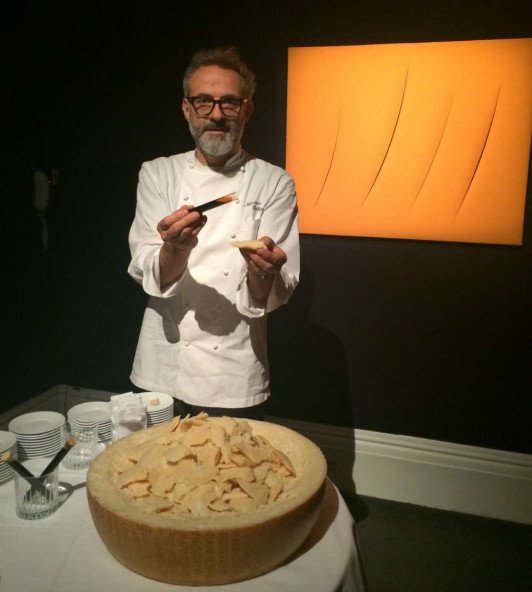
Second idea: nebulizing the flavour of Parmigiano, as a "sixth ageing", by the guest to whom the dish is served. Today's thought: «Too showy. We soon decided not to do it, it was no longer the time for making a show out of things». The final version Five ages of Parmigiano Reggiano, in different textures and temperatures can be dated back to 2013, that is to say 20 years after the initial idea: «Many dishes have evolved since the initial intuition passing through endless experiments, which continue to this day because the risk is that this recipe can become everyday. I believe this is also a message for young cooks: if you have a good idea, believe in yourself. Sooner or later, you will be acknowledged».
Finally, here's the recipe. But to enjoy it, it's best to visit Francescana at Maria Luigia, where they serve it among Bottura's super classics.
Five ages of Parmigiano Reggiano, in different textures and temperatures
Ingredients for 4 people
For the demi soufflé of Parmigiano
200 g organic ricotta
60 ml egg white
100 g grated Parmigiano Reggiano aged 24 months
40 ml cream
1 g di sea salt
0.5 g white pepper
Method
Oil some aluminium moulds sized 8 x 4 cm. Smoke the ricotta lightly with some cherry wood chips for 3 minutes in a smoker. Whisk the egg white till it's very firm. Whisk the ricotta. Add the Parmigiano to the cream, mix with the ricotta and season with salt and pepper. Add the egg white and cook the mix in the moulds for 45 minutes. Remove from the moulds and create some quenelles out of the soufflés.
For the Parmigiano sauce
20 ml unfiltered capon broth
100 g grated Parmigiano Reggiano aged 30 months
Method
Warm up the broth at 60 °C in a thermomix at medium speed. Add the Parmigiano and bring to 85 °C. Increase the speed and blend until the sauce is smooth and velvety. Strain with a Chinese colander.
For the mousse of Parmigiano
125 ml capon broth
250 g grated Parmigiano Reggiano aged 36 months
100 ml cream
Method
Pour the capon broth in a thermomix and bring to the boil at speed 3. Add the Parmigiano, one spoon at a time. Add the cream then increase the speed for another minute. Cool the liquid at 4-8 °C. Put it into a syphon, shake, charge twice and then shake again. Leave in the fridge for at least 1 hour at 4-8 °C.
For the Parmigiano wafer
100 g grated Parmigiano Reggiano aged 40 months
100 ml mineral water
Method
Pour the Parmigiano and the water into a pot and slowly bring to the boil, until the cheese starts to create threads. Remove from the stove and leave to rest at room temperature for 2 hours. Strain the liquid and place the solid part in the fridge overnight. Preheat the oven at 170 °C. Roll the cold cheese so it's 1 mm thick and place the pastry on a Silpat sheet. Bake for 12 minutes until the wafer is very thin. Leave to cool at room temperature, then break into 4 pieces, making triangles with irregular borders with a 5 cm side.
For the air of Parmigiano
200 g rind of Parmigiano Reggiano aged 50 months
200 g grated Parmigiano Reggiano aged 50 months
2 g lecithin
Method
Place the Parmigiano rind in a pot with 500 ml of water and simmer for 3 hours. Strain and leave to cool. Whisk the cold liquid and the grated Parmigiano for 30 minutes and leave the mix to rest in the fridge overnight. Strain with a cloth and transfer the liquid into a large bowl. Right before serving, add the lecithin and whisk with an electric whisk until you get a cloud of air.
Assembling the dish
Place 2 quenelles of demi soufflé on the base of each dish and place 2 spoons of sauce around the soufflé. Place the mousse on the side, add the cloud of air covering a fourth of the dish and then fix the wafer so it's slightly slanting.